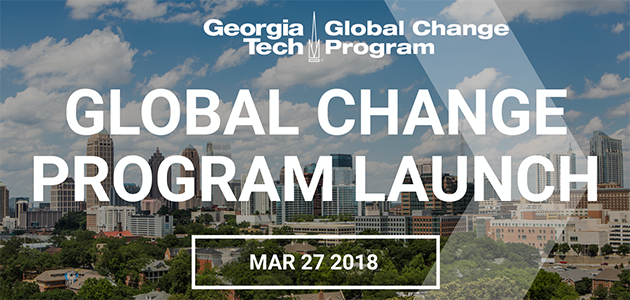 by Professor Marilyn A. Brown
by Professor Marilyn A. Brown
Presented at the Global Change Solutions Panel
Georgia Institute of Technology
March 27, 2018
Given that climate change is a global commons problem, global policy solutions are needed. The Paris Accord puts in place an international policy framework and is an important “first pivot”, but it is not enough to limit the global temperature increase to 2°C above the pre-industrial revolution. Even if every signatory to the Paris Accord meets its nationally determined commitment, global CO2 emissions will still continue to rise.
A “second pivot” is needed to turn down the historically rising levels of CO2 emissions. The solution options are spanned by the Kaya identity:[1]
- managing population growth,
- reducing the energy consumed per capita across the globe,
- consuming less carbon-intensive energy, and
- removing CO2 from the atmosphere.
As many of you know, I’ve spent most of my career on the energy efficiency term in the Kaya identify—the one that reduces CO2 by cutting our energy consumption. And by this I do not mean taking cold showers and drinking warm beer, or as one reporter said to me: living in windowless igloos. No, we’re talking about the high-tech advanced energy economy where micro sensors and smart meters generate extensive data that allows us to fine tune and optimize our energy appliances, machinery, and toys. An energy economy where electric vehicles are used both for mobility and to stabilize the grid; while intermittent renewables expand.
Energy consumption can also be reduced by addressing our energy addiction. Homes across the industrialized world boast a vast inventory of energy-hungry equipment: air conditioners, microwave ovens, bread makers, dishwashers, clothes dryers, tropical fish tanks, massage chairs, ice makers, home theatres, electric can openers, electric blankets, electric clocks, and of course, the hallowed “beer fridge”. Furthermore our addiction to cars dramatically escalates our energy consumption. Worldwide, households own approximately one billion personal automobiles – giant boxes of steel, wires and plastic that require 95% of the gasoline consumed just to push these heavy boxes around. In the U.S., there are more cars than people with driver’s licenses.
I have been struck by how little energy efficiency has been featured in the media debate over alternative energy futures—such as the Plant Vogtle expansion versus the expansion of energy efficiency. Energy efficiency has the same attributes as a power plant, but it doesn’t get its share of publicity -- no glamorous ribbon-cutting ceremonies because people see it as insignificant or trivial. One of my accomplishments during 8 years as a regulator of TVA was the modeling of energy efficiency as 20 MW power plants in TVA’s integrated resource planning. So another type of climate solution is advanced modeling and analytics.
Today, the term in the Kaya identity that is getting most of the attention is the use of low-carbon fuels. Oil shaped the last century … creating wealth that has bankrolled dictators, driven stock markets to new highs, and propped up the economies of unstable countries that are not allies of western democracies. Petroleum has been drip-fed to the western world, squeezing supplies out of circulation when prices get too low, and then flooding the market when prices are high so that alternatives like ethanol cannot survive.
Fortunately, the world is now transitioning to electricity as the preferred power source. With hydraulic fracturing and horizontal drilling, we now have cheap and abundant natural gas. The cost of solar and wind has plummeted. And lithium ion batteries are expanding the range of electric vehicles. As a result, the U.S. releases fewer CO2 molecules for every Btu of energy that we consume. And because electricity can be generated from so many different resources, it is difficult to monopolize, which promises a more democratic and peaceful world.
The last term -- carbon capture and sequestration – is also advancing. As a result, there is now an abundance of low-cost climate solutions.
It’s not rocket science. Many clean tech solutions are here already today. But our policy environment has thrown up barriers to them. The marketplace does not place a value on the clean air that they deliver or the climate change that they prevent. Without rewarding clean tech solutions for their environmental attributes, they often cost more than their dirtier counterparts, which by the way have received decades if not centuries of policy support.
In conclusion, my top solution for the Global Change Program is to put a price on carbon; then we can sit back and watch as innovators and entrepreneurs (from Georgia Tech and around the world) deliver market-ready and affordable clean tech solutions.
[1] Kaya, Yoichi; Yokoburi, Keiichi (1997). Environment, energy, and economy: strategies for sustainability. Tokyo [u.a.]: United Nations Univ. Press. ISBN 9280809113.
